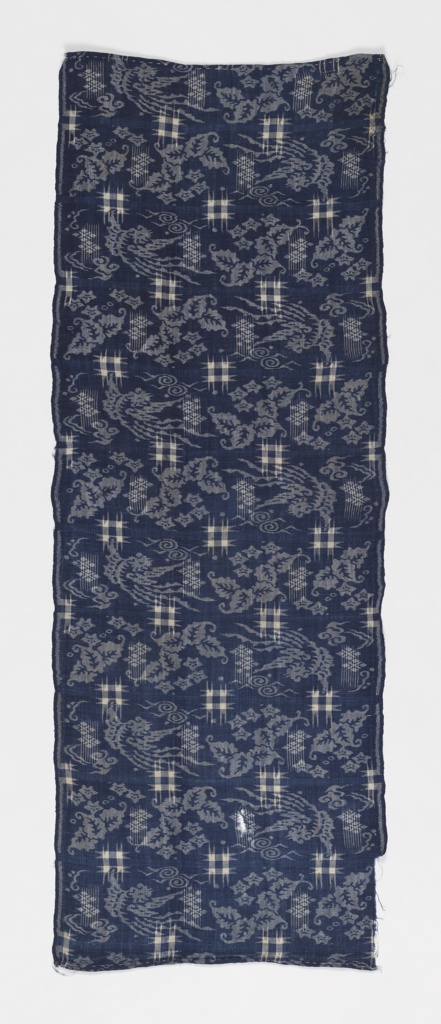Author: Robin Haller
In celebration of the third annual New York Textile Month, members of the Textile Society of America will author Object of the Day for the month of September. A non-profit professional organization of scholars, educators, and artists in the field of textiles, TSA provides an international forum for the exchange and dissemination of information about textiles worldwide.
I was in graduate school when I first fell in love with Japanese ikat weavings, called kasuri. Still, to this day, the beautiful indigo-dyed, patterned textiles ignite a sense of awe and excitement within me whenever I see one.
Ikat is the process of binding bundles of yarns in specific patterns before they are dyed. The binding resists penetration of the dye to the yarns, creating the desired pattern. Kasuri means “to blur” and refers to the fuzzy-edged imagery that results when the patterned yarns are woven. Japanese kasuri is typically weft-ikat, which is much more difficult to create than warp ikat, and often the warp also has resisted patterns strategically placed throughout the design. Kasuri fabrics were traditionally dyed in indigo and woven in the 12 to 14-inch widths used for making kimono. The narrow fabrics are sewn together to make garments, futon covers, and other household fabrics.
E-gasuri is pictorial kasuri and distinctive to the Japanese culture. The symbolic images in e-gasuri are from nature, folktales, and auspicious symbols. These fabrics are cotton or hemp and woven in a plain weave structure. In very special fabrics, the resisted yarns in both the warp and weft will align, creating a double ikat image. The technical difficulty of this process makes it a very highly prized and expensive textile.
This mid-19th century Japanese kasuri textile has stunning e-gasuri images of the phoenix, bunches of leaves, and flowers. There are images of clouds, a circular motif, and vertical lines that overlap some of the geometric designs creating distinct intersections of both warp and weft kasuri. Because the imagery is quite sophisticated, this textile is most likely a panel woven for a futon, possibly a wedding gift. Indigo dyeing became very popular during the mid-Edo period (1603-1867), and cotton and hemp were common fibers being used during the mid 1800’s to mid 1900’s in Japan. The mid-Edo period was a time of political stability, economic growth, and peace. The imagery supports this time period as well as being symbolic of a marriage ceremony. The Phoenix is an auspicious bird that makes its appearance when there is peace and happiness; the flower, which may be the plum or cherry blossom, symbolizes new beginnings, longevity, and/or peace; the vertical lines may represent bamboo which is symbolic of dependability; leaves are symbolic of fertility and growth; and the clouds might indicate elegance or the status of the bride’s family. The one symbol that eludes me is the circular motif. It closely resembles a flaming pearl, but that motif traditionally accompanies a dragon. The Phoenix is the female counterpart to the dragon, so maybe the flaming pearl is the yang to the Phoenix’s yin.
This is a beautiful example of what I consider to be among the most exquisite historic textiles, the traditional Japanese kasuri.
Robin Haller is an artist who specializes in digital design and weaving. She is Associate Professor and Area Coordinator of the Textile Design Program at East Carolina University.

2 thoughts on “Auspicious Symbols”
Leslie on September 24, 2018 at 10:51 am
Dear Robin,
This is an exquisite piece, thanks for sharing it! I would love to see a close up of the pattern.
Best,
Leslie
claudia phelps on October 20, 2018 at 7:09 pm
Informative description. How wonderful to work with something you love.